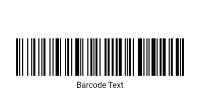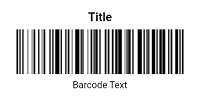The MSI-11 barcode is a variant of the MSI (Modified Plessey) symbology, designed to encode numeric data with increased capacity compared to simpler MSI formats. It offers a practical solution for applications needing to handle more complex numeric identifiers while maintaining the simplicity and reliability characteristic of MSI barcodes.
The MSI-11 barcode was developed to address the need for a numeric-only symbology with a longer data capacity than the original MSI-10 format. By allowing for 11-digit encoding, MSI-11 provides a more extensive range of numeric data, making it suitable for various applications in inventory management, retail, and other fields requiring detailed numeric tracking.
Technical Specifications
The MSI-11 barcode encodes 11 numeric digits and includes a modulo 10 check digit to ensure accuracy. The barcode structure includes a start pattern, the encoded data, a check digit, and a stop pattern, all represented by a series of bars and spaces of varying widths.
Key aspects of MSI-11 include:
- Start Pattern: Marks the beginning of the barcode sequence.
- Data Characters: Each of the 11 digits is encoded using a specific pattern of bars and spaces, providing a robust method for numeric representation.
- Checksum: A modulo 10 check digit is appended to verify the accuracy of the encoded data.
- Stop Pattern: Indicates the end of the barcode, enabling scanners to detect when the data sequence is complete.
Checksum Calculation
The checksum for MSI-11 is calculated using the modulo 10 algorithm, ensuring that errors are detected during scanning:
- Double every second digit, starting from the rightmost digit.
- Add all the resulting values together. If doubling any digit results in a number greater than 9, sum the digits of that number.
- Add the sum of the doubled digits to the sum of the remaining digits.
- Subtract the total from the nearest multiple of 10.
- The result is the check digit, which is added to the end of the barcode to enhance data accuracy.
This calculation ensures that the data encoded in the MSI-11 barcode is read correctly, reducing the likelihood of errors.
Advantages and Disadvantages
The MSI-11 barcode offers the advantage of increased numeric capacity, accommodating 11-digit identifiers compared to the MSI-10 format. Its inclusion of a check digit enhances data accuracy, making it reliable for various applications. The simplicity of the MSI format ensures ease of implementation and scanning.
However, MSI-11 is limited to numeric data, which can restrict its use in applications that require alphanumeric encoding. Additionally, its larger size compared to some other barcodes may be a limitation in space-constrained environments.
MSI-11 Applications
The MSI-11 barcode is used in various industries where accurate numeric encoding is required. Typical applications include:
- Inventory Management: Helps track and manage inventory items by providing a unique 11-digit identifier for each item.
- Retail: Useful for product identification and pricing, where detailed numeric data is needed for inventory control and sales processing.
- Warehouse Operations: Facilitates the tracking of bulk items and shipments, ensuring efficient management of stock and logistics.
Comparison with Other Barcode Symbologies
Compared to other numeric barcodes, MSI-11 provides a higher data capacity than simpler formats like MSI-10. While it is similar in function to UPC codes, MSI-11 allows for more digits and includes a check digit, providing greater accuracy. Unlike more complex barcodes such as Code 128, which can encode a wider range of characters, MSI-11 is specialized for numeric data and may not be as versatile.
The MSI-11 barcode is a practical solution for encoding 11-digit numeric data with built-in error detection. Its development as an extension of the MSI symbology makes it a valuable tool in inventory management, retail, and warehouse operations. While its limitations to numeric data and larger size compared to some barcodes may pose constraints, its increased capacity and accuracy make it a reliable choice for applications requiring detailed numeric encoding.


